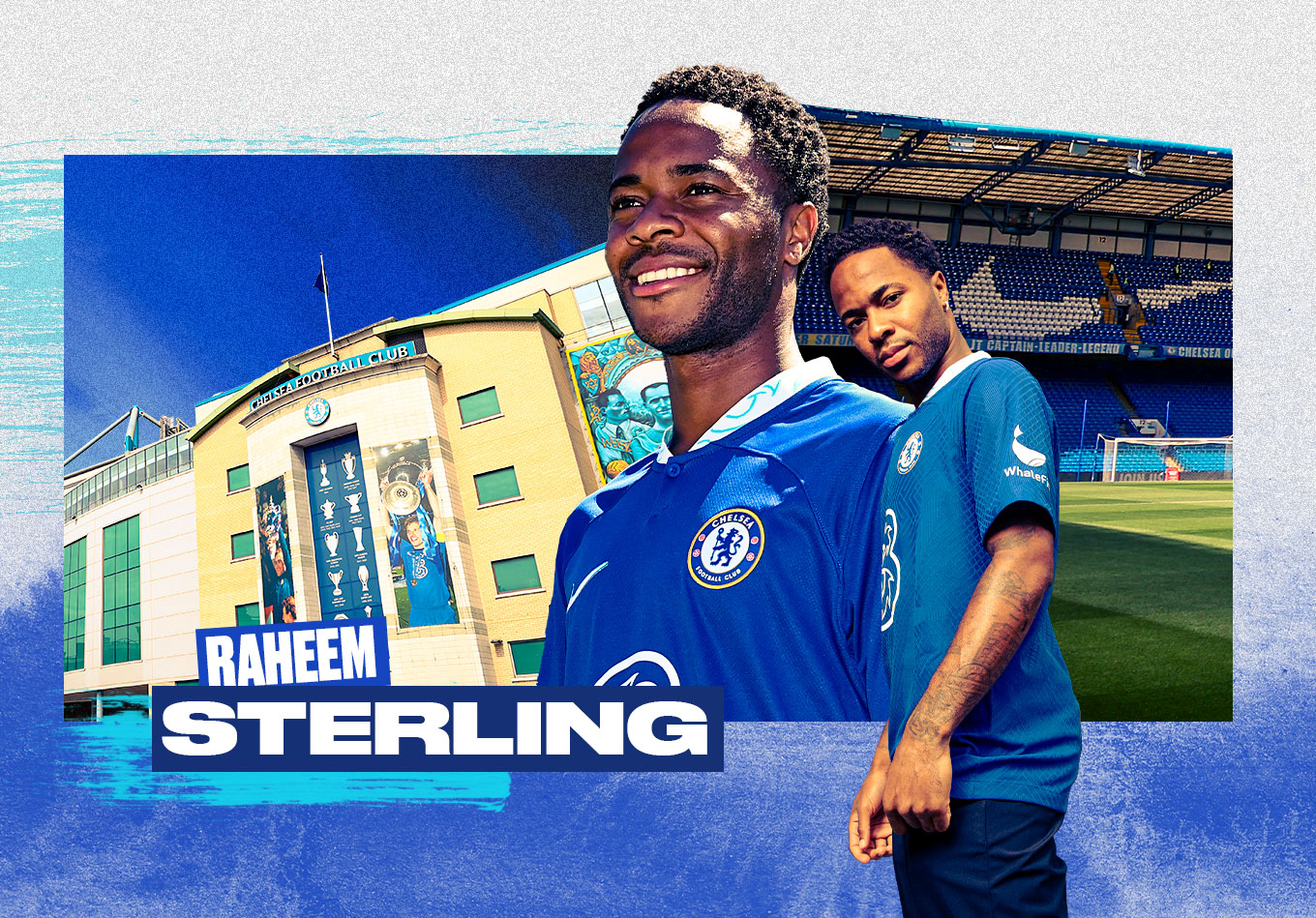Raheem Sterling is a footballer who never seems to get his due credit. He’s scored 114 goals and assisted 48 in the past five years for club and country, but people seem to remember his big misses as much as his big goals. He’s also been the target of malicious dog-whistle attacks from the tabloid press, with one morning’s headline reading “Sterling spends TOO MUCH!” followed by the next morning’s headline reading “Sterling spends TOO LITTLE!”.
Maybe another reason why public perception of Sterling has never reached the heights of where it arguably should be is that he’s never been the standout star man of his side. At Liverpool, there was Luis Suárez and Philippe Coutinho. At Manchester City, there was Kevin de Bruyne and Sergio Agüero among others, and at England, there’s Harry Kane. This is now set to change. To start off Todd Boehly’s spell as co-owner and chairman, Chelsea have signed Sterling for a rumoured £45-50 million as a statement signing.
Sterling joining Chelsea is a move that just feels right. It’s the kind of move you see the AI making in the first few seasons of a FIFA career mode playthrough or a Football Manager save. Slowly transitioned out of City’s first-choice dynamic, there weren’t many suitors for Sterling aside from Chelsea, who seem to be linked to every single footballer capable of playing wide. Chelsea’s set of expensive senior forwards – Timo Werner, Hakim Ziyech, Christian Pulisic, and even Kai Havertz to a certain extent – all lie on the spectrum of looking promising but inconsistent. Sterling fits the definition of a known quantity and Chelsea will hope that he can be their attack’s prolific, consistent centrepiece.
And, in a sense, this congruence makes Chelsea’s acquisition of Sterling almost boring. We know about him already. This flagship signing is very different from those of the new ‘big two’, Manchester City with Erling Haaland and Liverpool with Darwin Núñez, two young star forwards from abroad who retain just the right amount of mystique. Also, as we discussed earlier, in Sterling’s case, we know the lows as well as the highs. As a result, the consensus about the deal among Chelsea’s fanbase appears to be split.
We all have a bunch of questions about the move, and let’s have a look at as many as we can and try to answer them. In fact, there are so many pertinent questions that we created a little contents section for you:
What He Can Offer Chelsea
How Much of His Success at City Was Down to Playing in a Great Team?
Is He What Chelsea Need?
Where Will He Play at Chelsea?
Can He Press?
Is His Finishing a Concern?
Is There A Chance he Declines Soon?
Is He Worth the Money?
What Can He Offer Chelsea?
Sterling is a triple threat with his goalscoring, creative work, and dribbling, and Chelsea will be expecting big things from him. Let’s dissect each of those facets to see what he adds to Chelsea’s arsenal.
Goalscoring
The main thing that makes Sterling an attractive signing is his ability to consistently score goals. Since joining Manchester City, he’s scored 0.52 non-penalty goals per 90 minutes in league appearances, a number that puts him among the best forwards in England. After a relatively dry 2020-21 PL season where Sterling scored 10 (0.35 non-penalty goals per 90), he rebounded with 11 non-penalty goals in fewer minutes (0.47 per 90) last season. He also put up 0.51 non-penalty expected goals per 90, the sixth-highest in the league last season, which clearly shows that his goal tally wasn’t exactly a fluke.
A consistent feature about his goals is that they come from excellent movement. He’ll start his run before opposition defenders realise…
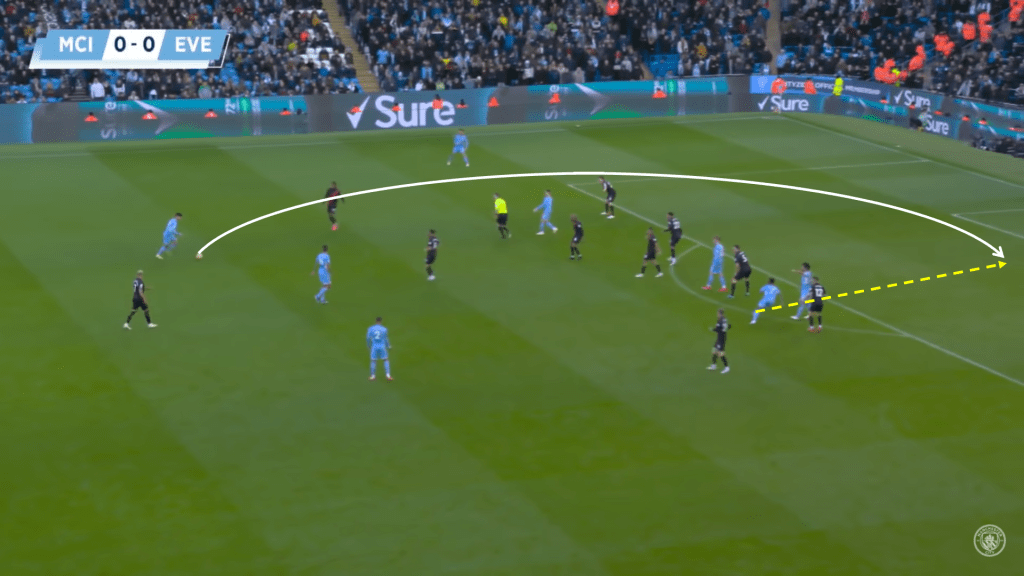
…he’ll switch lanes and move centrally at the right time, breaking into space…
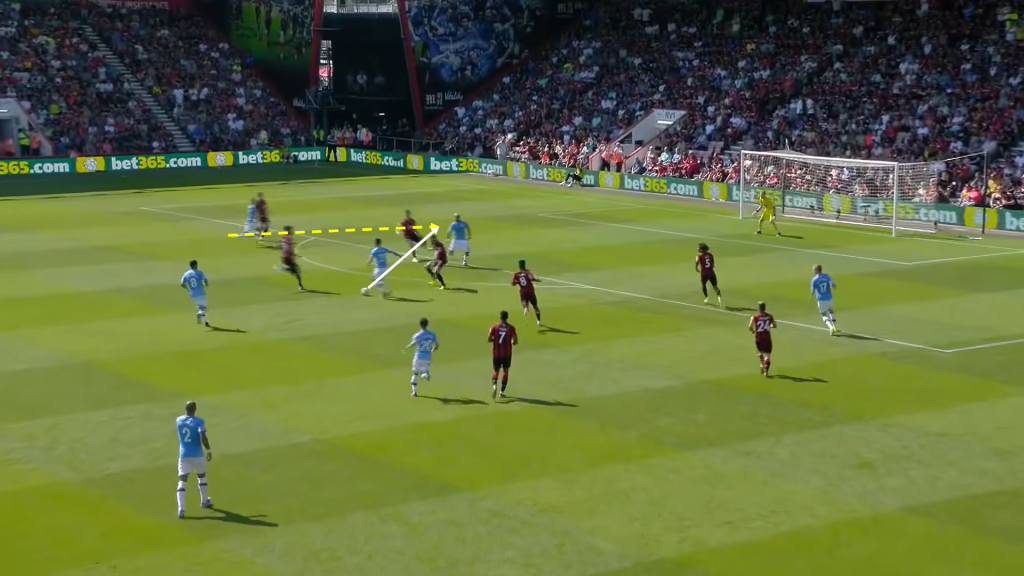
…or make a late darting run into the box from out wide, through the opposition full-back’s blindside…
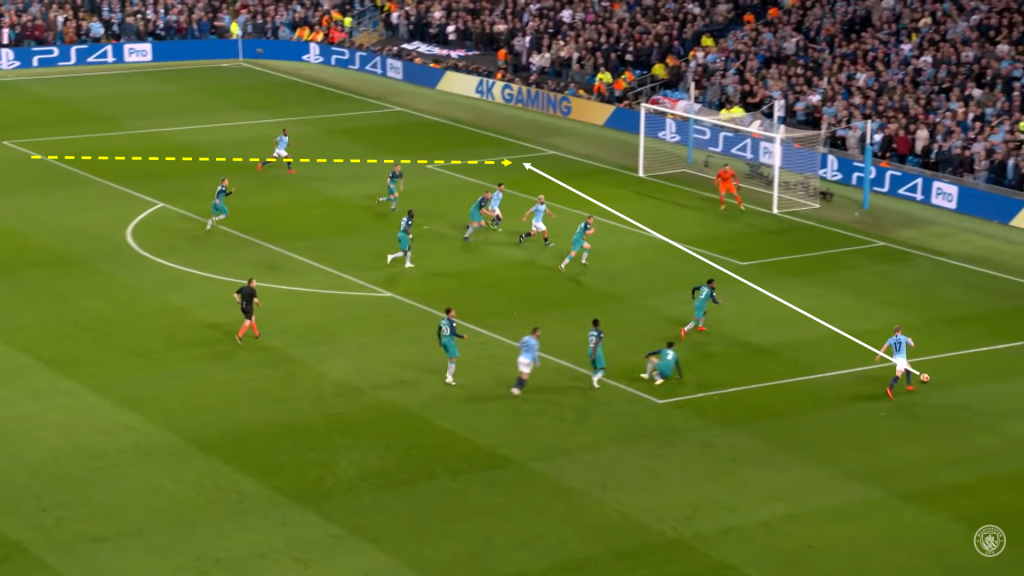
…he’ll change his speed, change his direction, or stop moving at the right time before defenders can adjust…
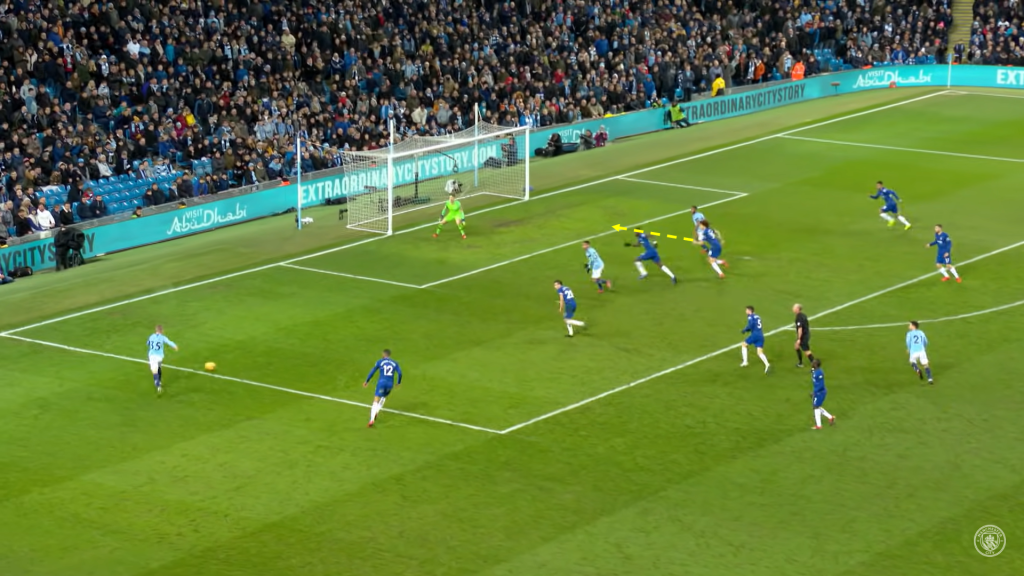
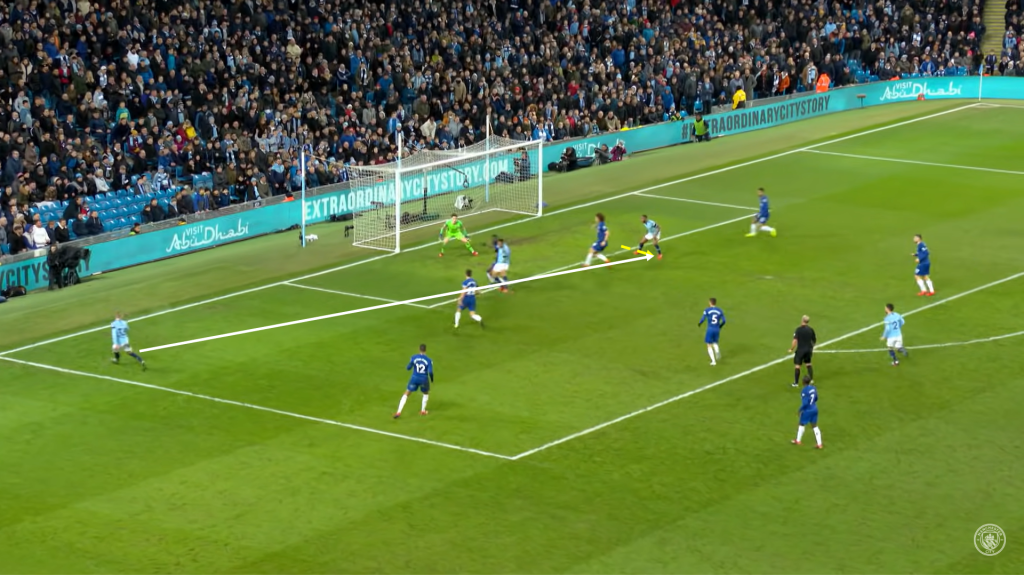
…and put the ball into the back of the net over, and over again.
As the shot map below illustrates, the upshot of this is that he’s able to get on the end of passes and shoot from close range. Just look at that cluster in the six-yard box. Few wide forwards shoot from the central, advanced locations that he does.
Among players who took at least 50 shots in the Premier League last season, Sterling’s expected goals per shot was the highest (0.22). Of course, playing for a side that generates high-quality chances like no other also helps (we’ll address that in a bit), but his ability to generate shots from excellent locations is second to none.
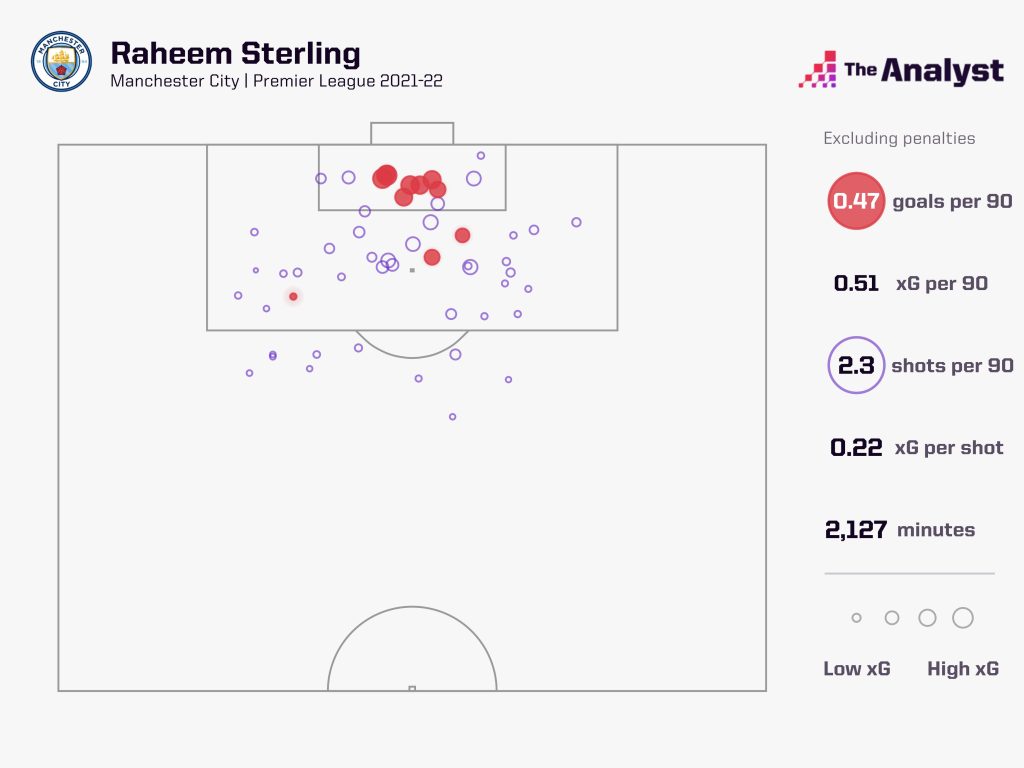
But his goalscoring ability goes beyond his movement. Sterling uses his dribbling skill to create shots – and goals – for himself. He’ll often receive the ball in space or out wide and make a quick, sharp carry to cut into space and shoot.
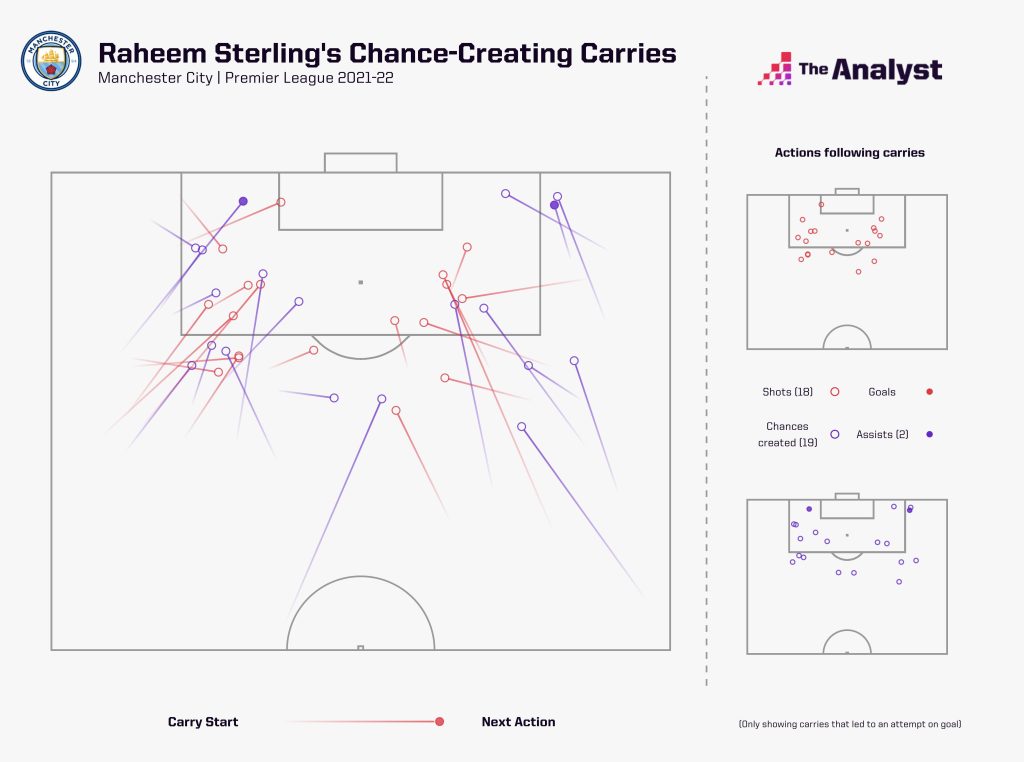
Lastly, there’s the question of his finishing, which we’ll discuss in depth in a bit.
Ball Progression
Sterling doesn’t only use his dribbling skill to create shots, he also consistently moves the ball forward into dangerous areas. Only Jack Grealish and Mohamed Salah carried the ball into the box more than Sterling did per 90 minutes last season He controls the ball excellently and modulates his pace, direction, and the weight of his touches to get past defenders and into lethal positions.
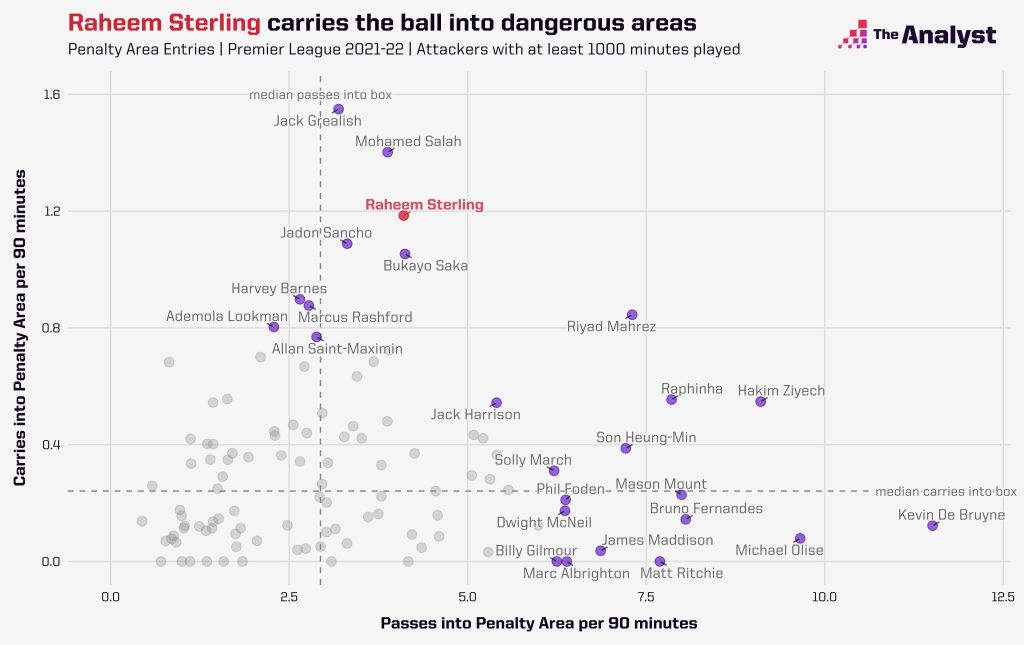
Sterling is also above-average for the rate at which he passes the ball into the box, too, which is something you’d expect at City.
So, Chelsea won’t just be getting someone who scores the goals, but also someone who lays the foundation of many more goals by taking attacks from the opposition’s half deep into areas close to the opposition’s goal.
Chance Creation
When Sterling carries the ball into the box, he has something that other great dribblers often lack: good decision-making. Instead of carrying the ball into traffic or shooting too early, he’s able to increase the potency of his team’s attacking move by intelligently laying the ball off to a team-mate. He picks the sensible pass and usually executes it well, something which presents itself in the numbers, too. In 2021-22, Sterling ranked 15th in the league with 0.19 expected assists per 90 minutes in open play.
In addition to his decision-making and execution, a large number of the shots that Sterling assists seem to spring from his excellent movement and dribbling, enabling him to get into space close to the goal before releasing the ball. He may play an easy-looking cutback to set up a goal, but the run or the dribble he executed right before the cutback is the hard part.
Here’s an example, at 21:31 in the below video, where he passes the ball back, makes a good run forward into space, and cuts it back to Agüero for the goal.
And that’s not the full extent of his creativity, which takes us to…
Space Creation
One ability of his that slips under the radar – maybe because of his more specialised, defined roles at City – is that he also creates space for team-mates when he carries the ball. Borrowing a concept from basketball, he’s a high-gravity player, pulling defenders towards him.
It’s especially clear when he’s playing for England, when he’s afforded greater fluidity with his positioning and is given more of the ball to dribble around with. When he receives the ball, he attracts a couple of defenders – creating space for his team-mates to attack – and keeps the ball under pressure, with his core strength.
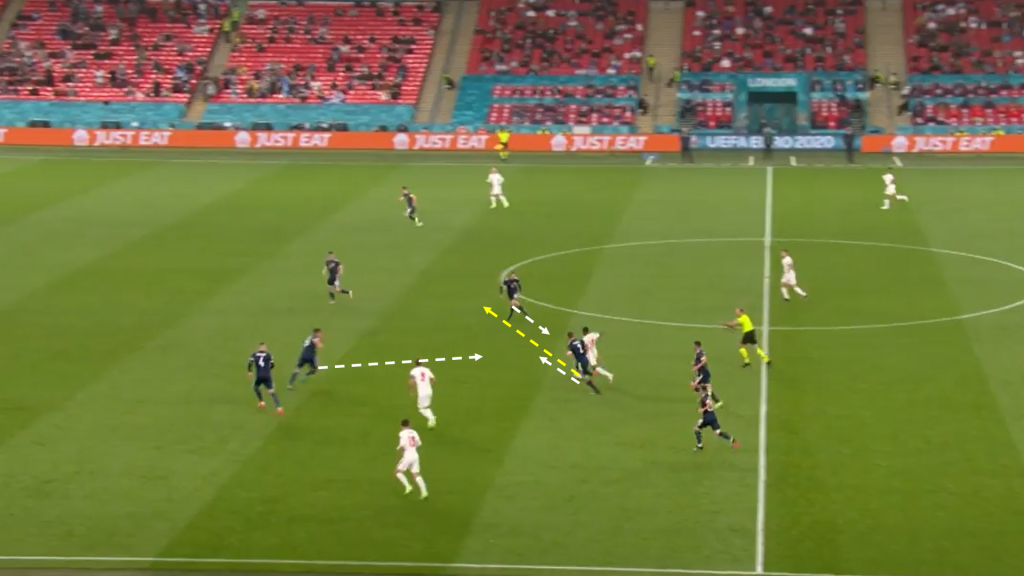
Individual gravity can dislodge defensive blocks and power up a stagnant attack immediately. It’s something that Chelsea have lacked consistently since losing Eden Hazard, whose gravity ensured that he’d create goals even if he wasn’t directly scoring or assisting them. Sterling will presumably have greater ball-carrying responsibilities at Chelsea, and his gravity can be a tool to pry open defences.
And that’s not the only kind of gravity Sterling possesses. His skill in movement and positioning also helps create space for his team-mates. On either flank, his wide positioning drags out and occupies a defender or two, leaving space for a team-mate to exploit.
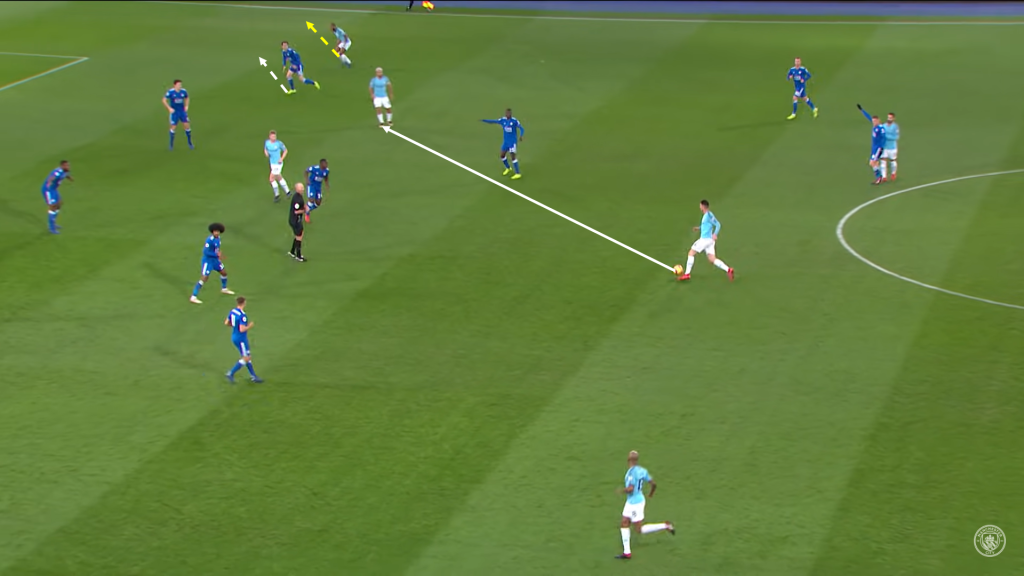
This seems to have been a valuable asset for City, raising the potential of their attacks, and Chelsea can hope to see it translate to their setup, too.
Finally, his positioning on the shoulder of the last defender and running in behind doesn’t only help him get good chances for himself, it also pushes the opposition’s defence back and creates space. This is especially useful in Guardiola’s City’s setup, where they methodically move the opposition deeper before cutting through them and scoring, and it’ll be valuable in Tuchel’s setup, too.
All in all, Sterling’s a multi-faceted, well-rounded attacker who helps his side in many ways, from moving the ball into space to putting it into the net.
Now, onto the big question.
How Much of His Success at City Was Down to Playing in a Great Team, and How Does His Success Translate to Chelsea’s Context?
We know all about what Sterling can do, but this is a big question mark. Sterling’s goal contribution stats may put him among the very best, but, of course, it’s much easier to put up those numbers when you’re playing for Guardiola’s Manchester City. Watch a compilation of Sterling’s goals, like this one, and on the face of it many of them appear to be down to the system or his team-mates, especially the goals assisted by cutbacks.
Of course, there’s enough in front of us to see that he gets a ton of opportunities at City. For starters, no player was targeted as often with a pass into the box as Sterling was last season (105 in total).
But goalscoring is much more than being the one who happens to be on the end of a good pass.
It’s an undeniable skill to pick the right lane to run into, to inject a burst of pace to get away from your marker, to time your run perfectly. Sterling’s finishes may seem easy, but it’s a product of the intelligent, incisive off-ball work he does that most other footballers can’t. Even the simplest-looking goals from cutbacks require good timing, staying in the full-back’s blindside, and modulating pace or direction at the right moment to get away from your marker. After all, there are reasons why it’s Sterling who’s been picked the most often and directly contributed to the most goals for City in the Guardiola era.
Let’s not forget, City aren’t the only side he’s played for in recent years. Even if we think of Sterling’s Liverpool spell as ancient history, his appearances for England paint an illustrative picture of his influence even in a less-dominant side with a less-defined tactical system. He picks the ball up all over the opposition’s half, carries it around, dislodging defences with his gravity, and moves it into threatening areas. He’s shown the ability to drive play, independent of what’s around him. This would be of great use to Chelsea, a side that needs all-around attacking improvement to challenge for the title.
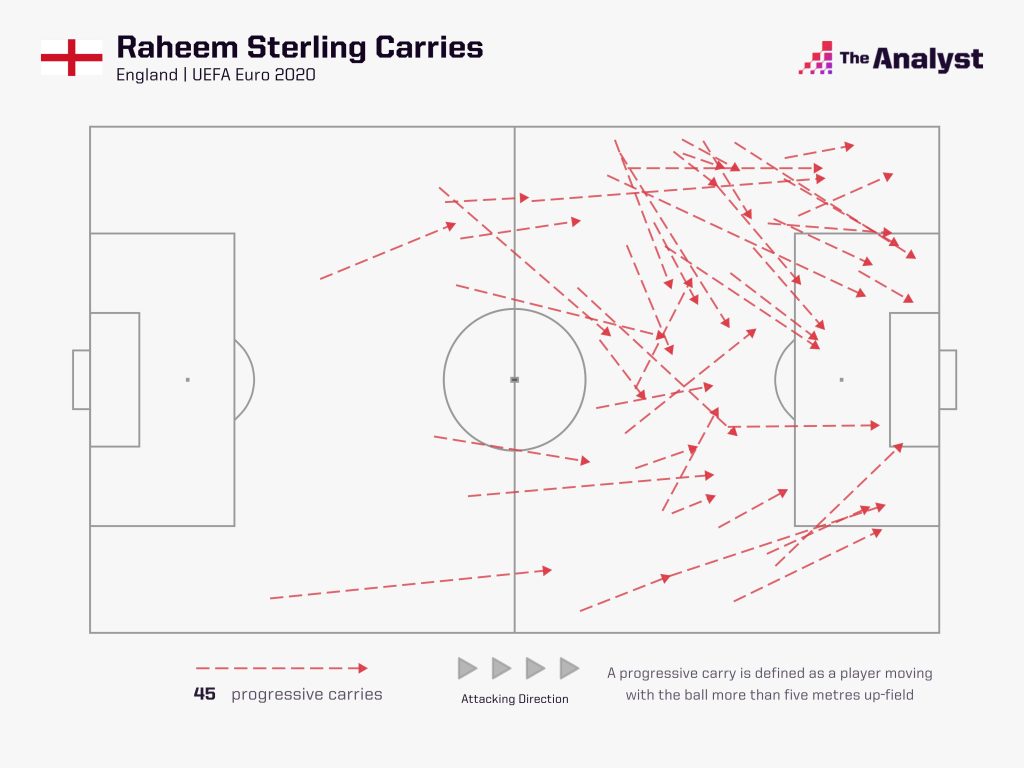
This is the version of Sterling that we’re probably more likely to see at Chelsea. He may not score as many goals, but it’s a version of Sterling that Chelsea require.
Of course, at Manchester City the system and his team-mates helped Sterling get as many goals as he did. But it doesn’t take away from the fact that Sterling creates incisive passing options, and thus goals, that wouldn’t exist without him. At the end of the day, a usually-first-choice superstar in City’s attack is unlikely to be anything less than one at Chelsea.
Is He What Chelsea Need?
Last season, there was undeniably a large gulf between the Premier League’s top two and Chelsea. To bridge this gap, Chelsea need to recharge their attack, which was 18 goals off Liverpool’s goal tally last season and 21 goals off City’s.
For starters, Chelsea need a goalscorer. Only Mason Mount reached double figures for goals scored in the league with 11. The level of decentralisation of their goalscoring wasn’t exactly by design, either. With the signing of Romelu Lukaku as a goalscoring focal point not working out, Sterling offers a low-risk alternative.
Last season, largely due to a lack of creative movement in behind, there was a tendency for Chelsea’s attacks to stagnate in the final third. And this is where Sterling’s movement comes in handy. Sterling made the fourth-most runs into the box last season with 283, and his addition also adds a constant option in behind the defence.
Moreover, Sterling being as well-rounded as he is makes him an immediate improvement on every attacking option Chelsea currently have at their disposal. He’s arguably a better dribbler than every other Chelsea attacker, better at making decisions in the final third than Werner, a better runner in-behind than Havertz, more efficient and consistent than Ziyech, and a better goalscoring threat than Mount.
A side that needs all-round improvement needs an all-rounder like him, and, as evident in his outings for England, he’s capable of being involved in different parts of the attack. While Chelsea may need to add a more creative passer to their squad too, they require a multi-purpose attacker like Sterling.
Where Will He Play at Chelsea?
One thing about Sterling is that he’s proven himself to be adept in different areas on the pitch. We’ve seen a lot of him on the wide right, especially in the 2017-18 season, where he’d stay close to the touchline and crash into the box to score.
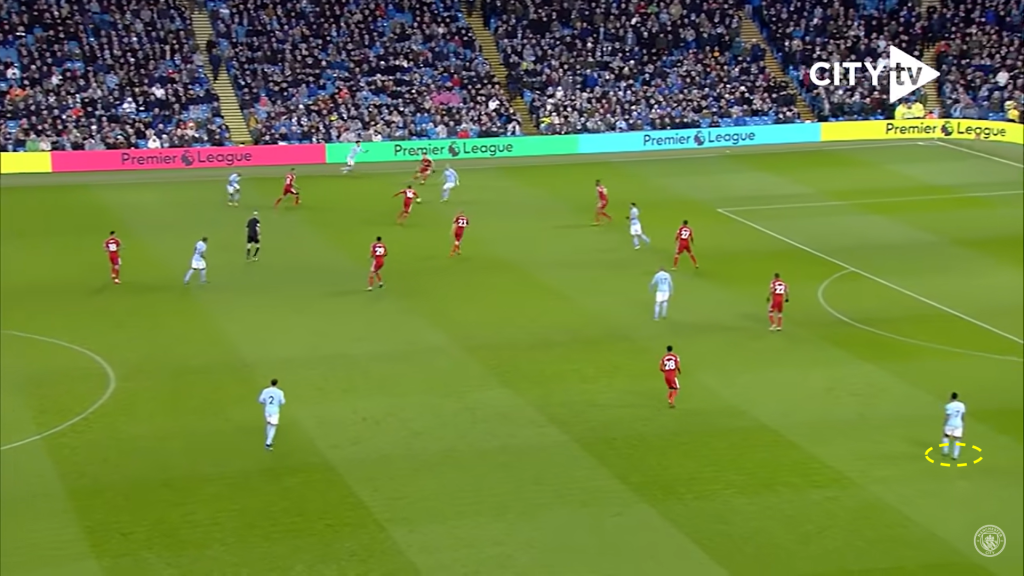
Otherwise, there’s the position he’s probably most comfortable at: as an inverted left-winger. He’d move in from the wings into the space between the right-back and right-sided centre-back to get on the end of chances.
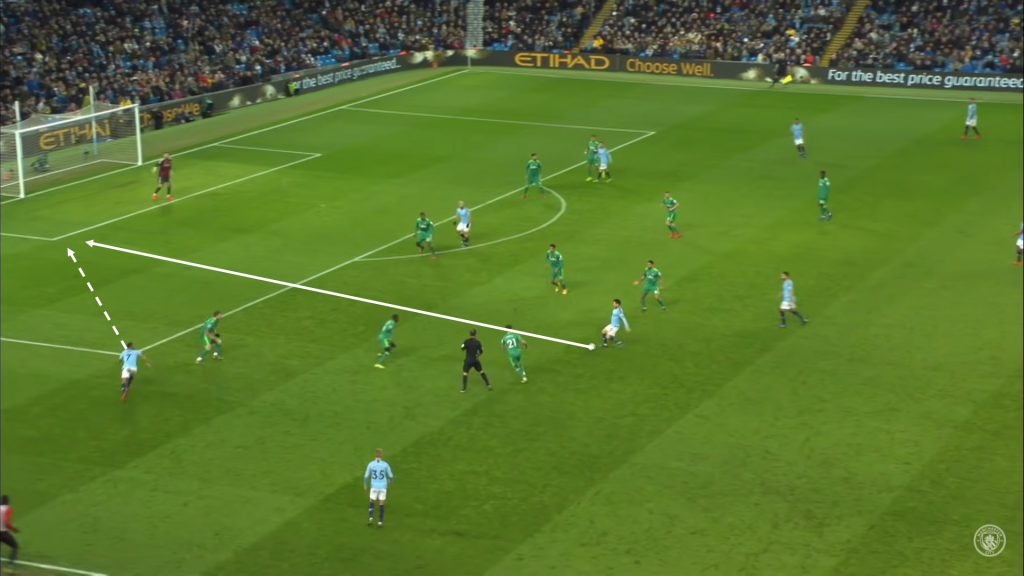
Lastly, whether it’s as a forward in a 3-4-3 or as a centre-forward in a 4-4-2 formation that Tuchel is rumoured to be considering, Sterling is likely to have to receive the ball in central areas – often between the lines – more frequently at Chelsea. He’s played as a number 9 occasionally at City, but the best model of what we can expect of him at Chelsea is probably what he does on national duty for England. For Gareth Southgate, he’s proven himself to be very effective in central areas, receiving between the lines. He often receives the ball in the hole, fends off pressure, passes it to a team-mate, and then makes an incisive run in behind.
One notable example is the buildup to his goal against Germany in Euro 2020. He picks up the ball in a deeper position centrally, attracts and dribbles past a couple of opponents, creating space (another example of his gravity), and passes it to Harry Kane. Kane passes it to Grealish, who plays it to Luke Shaw. Meanwhile Sterling’s made a mazy, curved run through the left and into the centre. Shaw crosses, Sterling connects, and it’s 1-0 England.
Despite the rumours of Tuchel using a 4-4-2 next season, I think the most likely outcome is Tuchel sticking with the 3-4-3, because of the value wing-backs Reece James and Ben Chilwell add when fit, and because of the upcoming reinforcements at centre-back. And instead of the rumoured centre-forward role for him that there’s been whispers about, I think Sterling’s more likely to be deployed as the left forward.
When Sterling came on at half-time for his pre-season debut against Charlotte, he did end up playing as the left-forward in a 3-4-3. Despite the side scoring no goals when he was on the pitch, the debut matched expectations of what kind of role he’d be playing.
When Chelsea moved the ball up the pitch, like how Chelsea’s wide forwards in the 3-4-3 are usually positioned, he’d usually start between the lines in the inside channels:
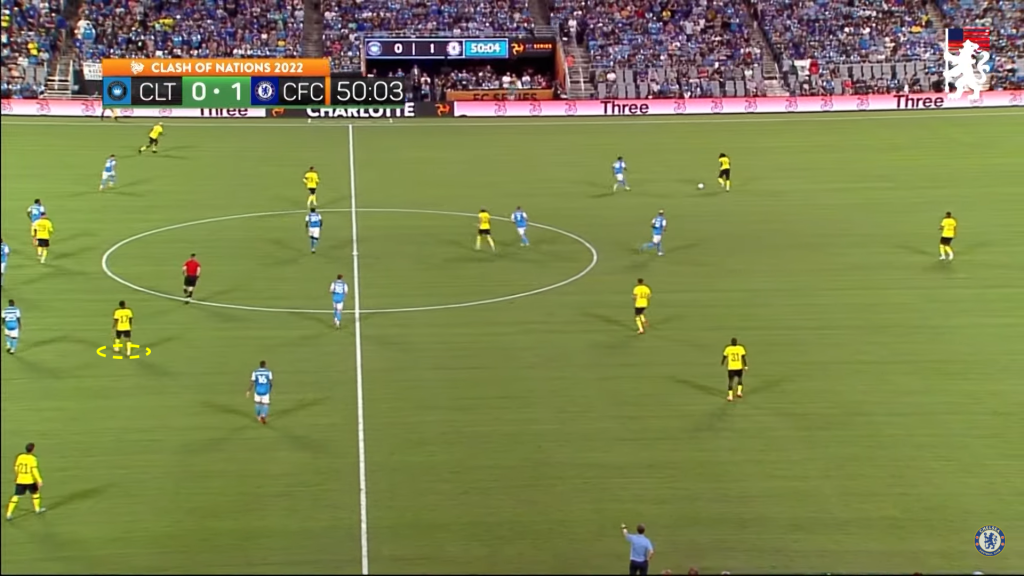
His movement across the pitch was fluid. He’d sometimes drop very deep to participate in the build-up as a passing option…
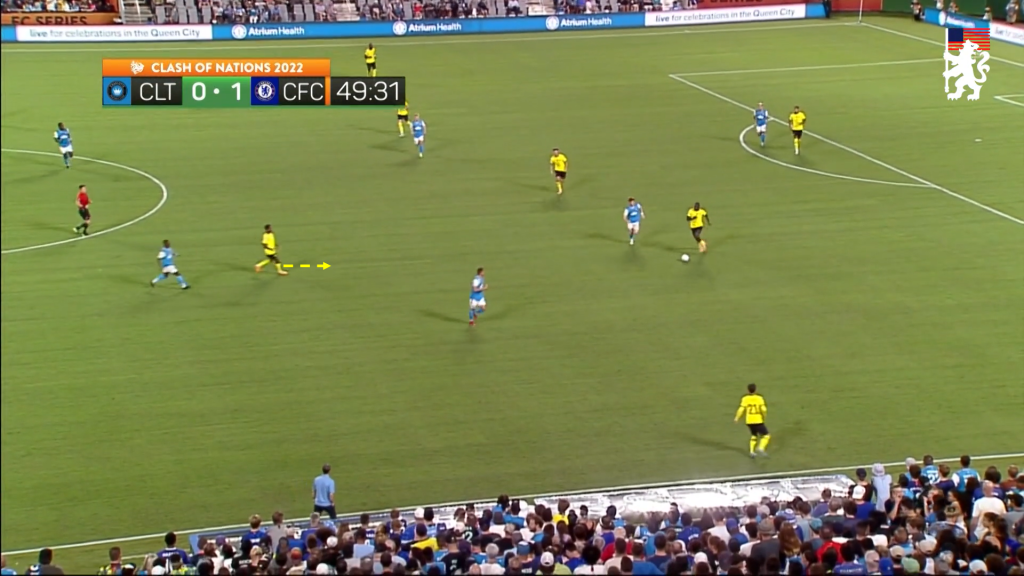
…occasionally move out wide, even on the other flank, on the counter-attack…
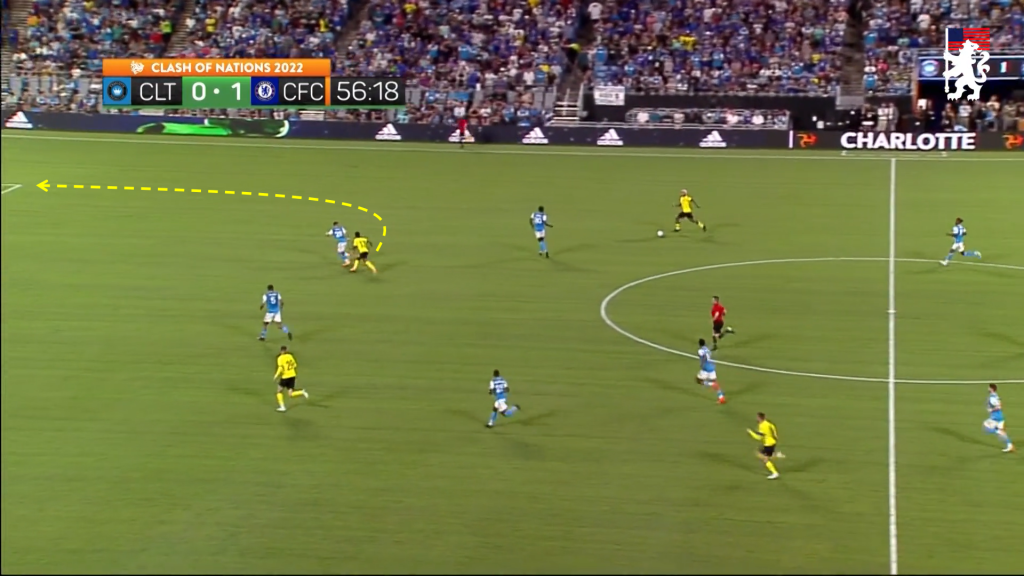
…and, of course, also make the kind of run we know him for, even if there wasn’t a pass for him to be on the end of.
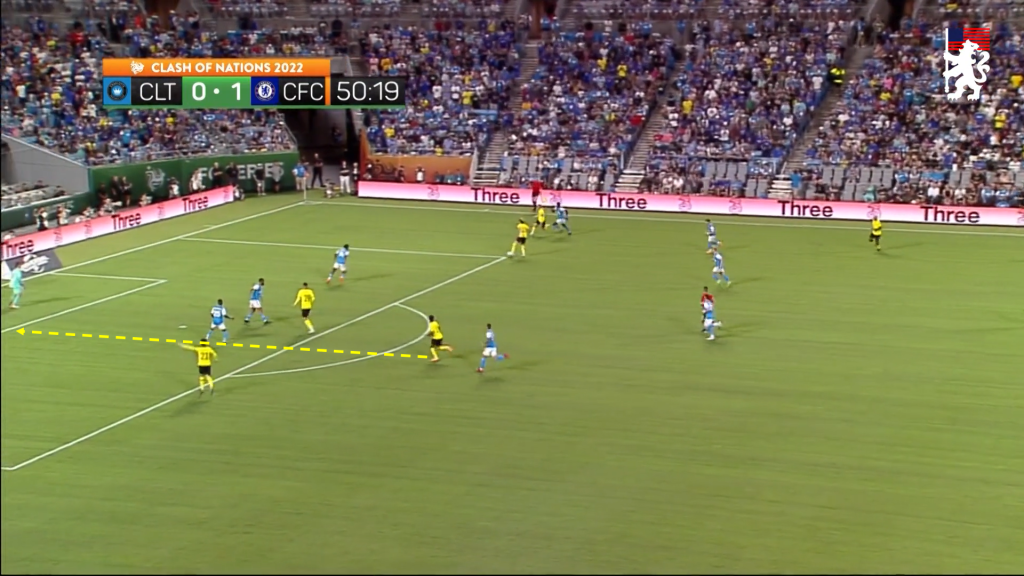
He’d usually receive the ball between the lines or around the halfway line and carry it forward through pressure, unsettling Charlotte’s defence.
Most of the time, after passing the ball after his carry, he followed it up with a smart run forward. This sequence at 4:39 in the video is an example:
Lastly, he also was the most frequent target of line-breaking progressive passes, which he received very well with his excellent first touch and core strength, and usually was the target of out-balls to set up counter-attacks.
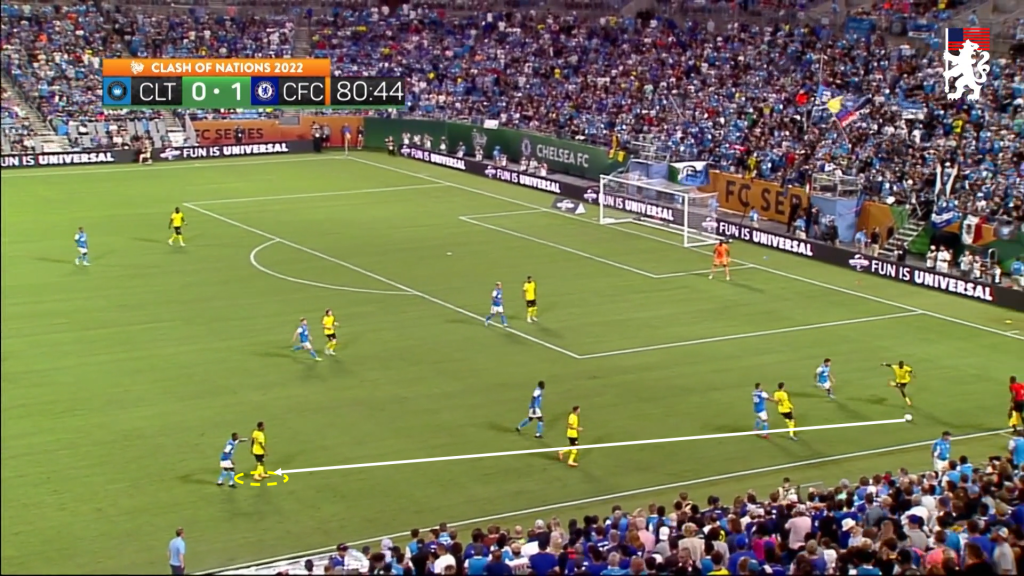
This performance was much more akin to what we’ve seen him do for England rather than for City, and we can expect a similar role going forward at Chelsea.
So, Sterling should be able to slot in well wherever Chelsea need him to, but arguably the best fit for both him and Chelsea is as the left forward in the 3-4-3 that Tuchel’s used so far. It gives him the space to be involved in different parts of possession sequences and allows him to make the full use of his skillset, which Chelsea very much need to bring their attack closer to the top.
Can He Press?
Yes, yes he can. Any forward in Guardiola’s high-pressing City side has to be a proficient presser as a part of the system, and Sterling is no exception. Among attackers, he made the ninth-most possession regains per 90 in the league last season with 1.1. Even when he doesn’t win the ball back directly, he diligently cuts off passing angles and suppresses the opposition’s build-up.
While Chelsea’s pressing was idyllic in their friendly against Charlotte, we could see flashes of it from Sterling. Here he is, curving his pressing run to deny passing angles, forcing the keeper to put the ball out of touch for a throw-in.
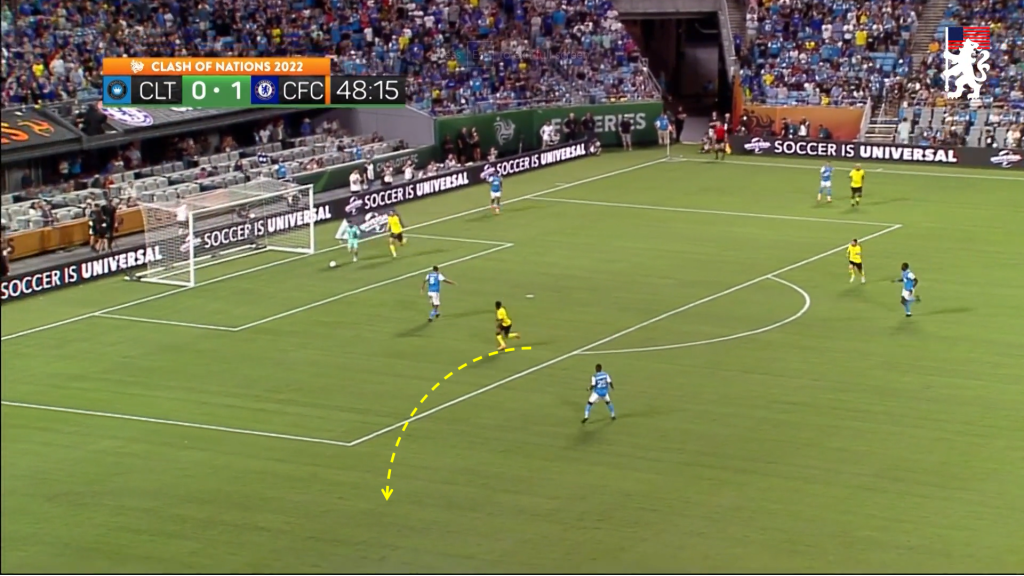
In general, Sterling’s far from a luxury forward, and I think we’ll see him become an integral part of Tuchel’s press.
Does He Fit the Vibes?
Yes. Look how good he looks in that shirt:
Is His Finishing a Concern?
One of the first things anyone brings up when discussing Sterling is his finishing. We can all recall some of his big misses that make you want to throw your television set out of the window. It’s usually the main critique levelled at him, and it’s the main thing that makes some fans slightly sceptical about the transfer.
What do the numbers say? Comparing expected goals to actual goals to evaluate finishing, no matter how large the sample, doesn’t always work, so instead, we can have a look at expected goals on target (xGOT) or post-shot expected goals, which takes into account how well players place their shots on target on the goalmouth. This isn’t the best method either, considering that it excludes shots off target, which means excluding near misses and blocked shots, but it’s a start.
Compared to his xG of 88.34 since joining City, his xGOT in the same period is 87.83, giving him an xGOT/xG ratio of 0.99. Among players who’ve put up at least 10 xG since Sterling’s debut at City, this ratio is in the 56th percentile. Put more simply, it implies he’s an average finisher.
Setting the filter at 40 xG or more over that time period, so we’re just looking at the good goalscorers, Sterling’s further below-average, in the 44th percentile, and way below the likes of Son Heung-Min, Harry Kane, and Mohamed Salah. But it’s still higher than some other top forwards who don’t receive the same amount of scrutiny over their finishing, like Sadio Mané and Pierre-Emerick Aubameyang.
So, the post-shot expected goals stats say that Sterling’s an average finisher compared to most players, and below-average relative to other great goalscorers. Some of us may disagree with this, arguing that he’s a worse finisher than that. I thought his xGOT numbers would look much worse, too. But there’s a simple reason why he looks like a worse finisher than he is: very few players get on the end of as many high-quality chances as he does. A below-average finisher with the number of chances Sterling creates for himself will miss a lot more great chances, and these missed great chances stick in your head.
Moreover, as Bobby Gardiner’s seminal piece on Sterling’s finishing explained, you don’t need to be a great finisher to be a great goalscorer. “Finishing matters,” Gardiner writes, “but the ability to bend a ball into the upper corner pales in comparison with the ability to get in position to take the shot.” Contrast this with Chelsea’s last real talismanic forward, Hazard, who was a great finisher (for example, his xGOT/xG ratio is in the 98th percentile), but he didn’t score as many goals because of his lack of movement in behind. When Sterling’s off-ball movement generates as many great shots as it does, his finishing becomes much, much less of a concern.
Will He Decline Soon?
So far, we’ve discussed what he can offer Chelsea now. But perhaps a bigger question is what lies ahead, and how long he can do it for. He may be 27 ‘till he’s 28, but Sterling is turning 28 in December, which is already a risky age to buy him at, considering how most wingers peak at around 26.
It’s an even bigger risk in Sterling’s case, who’s played more than 33,000 minutes throughout his senior career. His legs have the mileage of those of a forward approaching their mid-thirties. Even though there’s no hard evidence to back this up, conventional wisdom states that accumulating lots of minutes earlier on in your career can result in an earlier decline, as the examples of Wayne Rooney and Cesc Fàbregas among others seem to tell us.
But one counterpoint to this is that Sterling’s injury record is tiny. According to Transfermarkt, he’s only missed 25 games to injuries throughout his career, and he has no recurring injuries. He doesn’t have a lot of wear and tear, which could mean good things for his longevity, or at least that his later years won’t carry the consequences of accumulating injuries.
Another potential issue is that Sterling’s game is fairly dependent on his pace, specifically his acceleration and explosiveness. While he times his off-ball runs very well, his ability to get close to high speeds before defenders can change direction and catch up enables many of his chances in space. Moreover, his dribbling skill is also quite dependent on modulated pace and acceleration from a standing start, and this too would become less effective with time.
I’m no sports scientist, but whether he starts his decline earlier or ages like an average winger, his age does come with certain risks. He may have to adapt his game in the later years of his long contract.
Which takes us to our last question.
Is He Worth the Money?
The (*quickly opens the calculator app to add up yearly wage costs and amortised transfer fees*) 130ish-million-pound question. If the rumours of a £45-50 million transfer fee and weekly wages exceeding £300,000 are to be believed, Sterling would cost Chelsea at least £26 million every season for the next five-to-six years.
On the face of it, a transfer fee of £45-50 million isn’t much for someone as prolific and established as Sterling, but it is a symptom of how the market for players nearing their thirties has diminished. Especially in Sterling’s case, as a close-to-28-year-old who, as we mentioned earlier, may be beginning the slope of his career.
The overall amortised costs make things a little harder to judge. The £26 million every year may look great in the first two seasons, if he does nearly as well as expected. But the amount will start to look much, much more expensive when he reaches the later years of his contract, with Sterling in his early thirties, and potentially on the decline. Of course, you can make the argument that these costs matter much less to Chelsea’s ownership in the early years of their stewardship, but every million spent has an opportunity cost. This is a signing that isn’t likely to have much long-term value.
In summary, while I think Sterling’s overall costs are likely to be worth it in the short term, the deal is bound to look over the top with time. But that may not be a huge issue if challenging for the title and the Champions League immediately is the new ownership’s primary objective.
Conclusion
You’d expect a new owner’s first key decisions at an already-big club to say something about what we’ll see throughout their reign. The signings of Sterling and Kalidou Koulibaly signal an attempt to sign established, experienced names who command high overall costs. They seem like decisions geared towards the short term, but at the end of the day are low-risk signings.
That being said, despite the limited risk of Sterling’s move ‘flopping’, we can’t expect his time at Chelsea to be the same as what we’ve seen before. At City, we’ve seen a version of Sterling who’s more of a ceiling-raiser, with a defined, specific role that helps make a great attack a near-unstoppable steamroller. But at Chelsea, where the objective is to make a good attack great, expect to see him pick the ball up deeper and create many attacks himself.
We may see a lot more of him using his entertaining dribbling box of goodies and creativity, but he may not score the same number of goals every season. And that’s crucial to how we set our expectations of the move and how we evaluate it.
It’s inevitable that Sterling’s value to the side drops as his age and experience begin to catch up with him. But until then, it’s an exciting time for Chelsea, because they now have a new star their attack can revolve around.
Enjoy this? Subscribe to our mailing list to receive exclusive weekly content.
Design by Matt Sisneros
